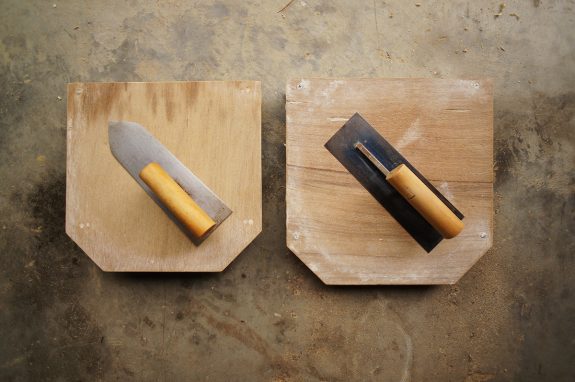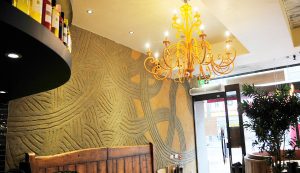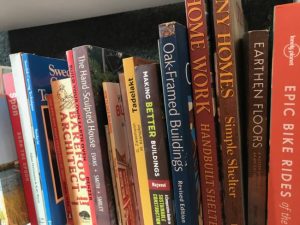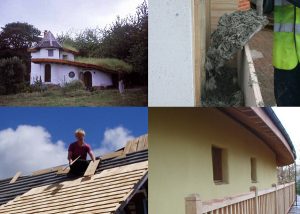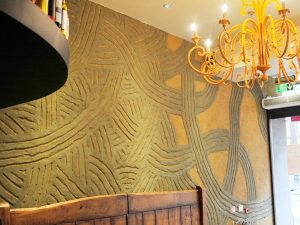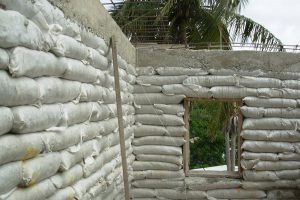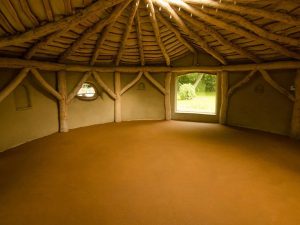Inspired by the magic of traditional Japanese clay plastering, USA-based natural builder Ziggy Liloia of The Year of Mud shares his step-by-step guide to making a Japanese plaster hawk.
Clay plastering is a niche craft in Japan, but the tradition has been unbroken for hundreds and hundreds of years. It’s not practiced as widely as it once was, yet the quality of the work that is done is exceptional. It’s serious business, and absolutely beautiful and inspiring too, as can be seen in this video.
Japanese-style plaster hawks are a comfortable, ergonomic alternative to the typical hawk design you come across in the United States. Best of all, you can very easily make your own with only a few basic materials and customize the proportions to your liking. Here’s how you make your own Japanese plaster hawk.
How to make a Japanese plaster hawk
There’s not much required in way of time or materials to make a serviceable Japanese plaster hawk. A scrap of sheet material for the top and some narrow strips of wood for the handles will get you there. Here are some tips.

This is all you need to throw together a respectable hawk. Credit: The Year of Mud
1. Making the board
I like to use luan for the board. Luan is the thin sheet good product that is commonly used under vinyl floor installations. The key here is that it’s lightweight and very thin (about 1/8″ thick), but also durable and resistant to water damage. I have a collection of luan scraps from taking out floors and dismantling old kitchen cabinets that I use for making new hawks.
The dimensions of your board can be customized to your liking. Start with something like 12 1/2″ long by 12″ wide. You can vary those dimensions up to an inch, but 12 1/2″ x 12″ should give you a reasonable surface area. Cut off the two corners that will face you at a 45 degree angle.

Soften the edges of the handle with sandpaper to make it more comfortable. Credit: The Year of Mud
2. Shape the handles
Use small pieces of a lightweight wood (such as pine or poplar) to construct the handle, about 3/4″ thick by 1″ wide. Again, this can vary based on the size of your hand, but these dimensions should be comfortable for most plasterers. Use a piece of sandpaper or a block plane to remove the sharp corners on the diagonal handle piece. This will make the handle much more comfortable to hold. Cut your handle material to length and install the cross piece at an angle… not quite from corner to corner, but a little less, like this:

Here’s how the handle should get attached to the back of the hawk. Credit: The Year of Mud
3. Screw the handles to the board
You can attach the cross pieces directly through the top of the luan. Use a screw with a small head, ideally, and be sure to set it just below the surface. The screws will not interfere at all with your trowel as long as they are barely sunk under the surface.

These trim screws are ideal for attaching the wood strips to the back. Credit: The Year of Mud
4. Use it!
That’s about all there is to it! Easy, huh? Make a couple while you’re at it, so you have some ready for friends or work partners. If you have the material lying around, it shouldn’t take more than 5-10 minutes to throw one together!

Ready for action! Credit: The Year of Mud
This article is kindly reproduced with permission from an original post by Ziggy Liloia at The Year of Mud. Photos and text are the author’s own. To find out more about clay and earth plasters, read our topic introduction here.
In 2008, USA-based natural builder Ziggy Liloia launched The Year of Mud with the construction of his first cob house. The website is home to many of his personal stories and experiences building with clay, straw, and wood over the past 10 years. In 2012, Ziggy and his partner April began to offer natural building workshops, enabling others to learn essential hands-on skills to build their own natural homes.

